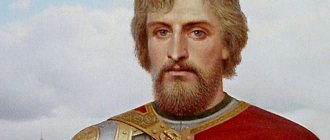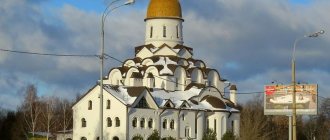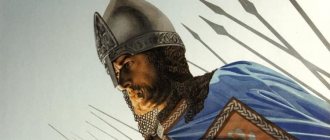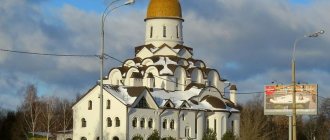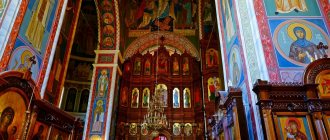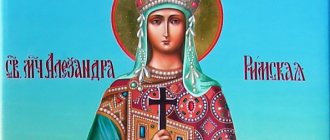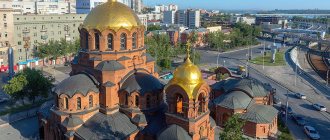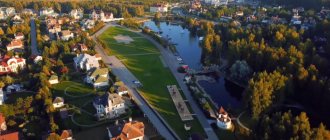In Vladimir
The legendary commander was buried in the Nativity Monastery in Vladimir. Doctor of Historical Sciences Roman Sokolov wrote about this in the article “The Canonization of Alexander Nevsky and the Fate of His Relics,” published in the magazine “Christian Reading” (No. 2 for 2021). The researcher noted that the body of the prince, who died in Gorodets-on-Volga, was transported to Vladimir, since this city was the nominal capital of North-Eastern Rus'.
Soon after his death, the veneration of Alexander Nevsky began. In 1381, the remains of the prince were removed from the crypt and placed in a special sarcophagus. In 1491, a terrible fire occurred in Vladimir, in which many church relics were damaged.
In 1547, Alexander Nevsky was canonized at the Patriarchal level, and in 1591, Archimandrite of the Nativity Monastery Jonah Dumin compiled a new version of the prince’s life, in which he argued that the fire that happened a century ago did not affect the relics of the commander.
Another outbreak of fire occurred in Vladimir in 1681. This time, not only all the icons burned, the flames also touched the remains of Alexander Nevsky. True, it is unknown how much they were damaged and what part of them survived. In 1697, the surviving relics were transferred to a new shrine.
What is actually the main feat of the Grand Duke?
For almost 7 decades, while the holy relics of the prince remained in oblivion and neglect, Soviet propaganda intensively mythologized the image of Alexander as a great warrior, commander, and defender of Rus'. The film by S. Eisenstein (1938) is well known, where the commander is played by the famous Nikolai Cherkasov.
Less is known about the fact that on the Order of Alexander Nevsky (existed from 1942 to 1991) it is the profile of the actor, because not a single lifetime image of the blessed prince has been preserved.
The great battles of Alexander - the Neva and the Battle of Lake Peipus - also remained in people's memory thanks to the power of cinematic art. Only modern historians have found out: the significance of these battles was much less than Alexander’s refusal to the Pope, who offered him help in exchange for betraying Orthodoxy. And the prince most likely received the nickname “Nevsky,” according to a modern researcher of the era, I.N. Danilevsky, simply because he had some family lands near the Neva River.
The beginning of a new understanding of the life path of the noble prince almost coincided with the return of his honest relics to the revived monastery. It happened on June 3, 1989.
In Petersburg
Doctor of Historical Sciences Mikhail Shkarovsky described all the vicissitudes that happened to the remains of the legendary commander in the article “The Fate of the Relics of Holy Prince Alexander Nevsky in the 18th – 20th Centuries,” which was published in the magazine “Palaeorosiya. Ancient Rus': in time, in personalities, in ideas" (No. 1 for 2022).
The scientist said that after the end of the Northern War, Emperor Peter I Alekseevich decided to move the remains of the defender of Rus' from the Swedish invaders to the newly founded capital. The image of the legendary commander symbolized the historical victory and was supposed to inspire the people.
On August 11, 1723, the ark with the relics of Alexander Nevsky was taken out of Vladimir. Before the official date of the celebration, the shrine was placed in a special pavilion equipped in the Shlisselburg fortress. And according to M.V. Shkarovsky, this pavilion soon burned down. That is, the remains of the prince could have been damaged in a fire for the third time. But, one way or another, since then they have been in the Annunciation Cathedral.
In 1750, Empress Elizabeth Petrovna ordered the production of a new silver shrine for the relics of the commander. They were translated into a 300-pound work of art in the Baroque style.
And by the decision of Catherine II, the Cathedral of the Holy Trinity was built in St. Petersburg, where the shrine with relics was solemnly transferred in 1790.
Brief Life
The young prince faced difficult times - Rus' was torn apart by internecine wars. Moreover, ill-wishers attacked from all sides. As a youth, Alexander took princely vows and received a blessing to defend his homeland. When he turned 16, his father left his young son to rule Novgorod on his own.
In 1239, Alexander married the daughter of the Prince of Polotsk, who received holy Baptism. The father blessed the young people with the miraculous image of the Mother of God - the Feodorovskaya icon was always near Nevsky until his death.
The Mongols were advancing on Rus' from the east, and the crusaders, incited by the Roman authorities, were advancing from the west. Everyone wanted to weaken the Russians and destroy them. But the Lord sent His warrior - Alexander, who was not yet 20 at the time. After prayer in the Church of Hagia Sophia, he led his squad against the enemy.
Work as a courier at Yandex.Eda (up to 3,400 rubles per shift) leave a request →
The Grand Duke accomplished many glorious deeds. The Lord placed great responsibility on his shoulders. He began to rule the Vladimir, Novgorod and Kyiv principalities.
- 1253 - repulse another attack on Pskov.
- 1254 - peace treaty with Norway.
- 1256 - campaign in Finland.
- 1256 - Khan Batu died, then his son Sartak, with whom the prince built a trusting relationship.
- 1262 - the last journey of Saint Alexander to the Horde.
Returning to his homeland, the prince became seriously ill. Anticipating his imminent death, he became a monk with the name Alexy. The righteous man departed to the Lord in the Feodorovsky Monastery. The relics of Alexander Nevsky were delivered to Vladimir. During the religious procession, the body remained incorrupt.
Autopsy 1917
In June 1917, Metropolitan Veniamin (Kazan) of Petrograd and a number of other church hierarchs opened the sarcophagus of Alexander Nevsky. The First World War was going on, the city was almost captured by the Germans, and it was decided to prepare the relics for evacuation so that they would not fall to the enemy.
Under the lid of the reliquary, the priests saw a cypress coffin in which lay... a stuffed animal, the head of which was made of wax, and the body of cotton wool sewn into silk. Inside the stuffed animal were: bones of arms and legs, part of a skull and two ribs. Nearby was a bag of small bones. It also contained a note: “On the 20th day of May 189, these relics of the blessed Prince Alexander were collected after the church burning, then all the icons burned.” Subsequently, scientists established that the note refers to the Vladimir fire of 1681.
Church leaders suggested that the effigy of the prince was made under Peter I to hide the truth from the people: most of the remains of Alexander Nevsky were destroyed by fire. Most likely, the sovereign-emperor knew about this.
After consulting, representatives of the Orthodox clergy decided to separate the prince’s relics from foreign objects, which was done on July 24, 1917. The preserved remains were placed in a cypress casket and returned to the shrine. The above-mentioned note and decayed parts of the monastic schema (vestments - editor's note) of Alexander Nevsky, who took monastic vows shortly before his death, were also placed there.
Various researchers subsequently assumed that at the height of the revolutionary unrest, the clergy replaced the relics of the prince or removed most of them, wanting to save the shrine from possible desecration.
Home »»» Death of Alexander Nevsky The Grand Duke of Vladimir, Alexander Nevsky, on his way back from the Horde, died as a schema-monk under the name Alexy, November 14, 1263, in the Gorodets Feodorovskaya monastery. Metropolitan Kirill III announced to the people in Vladimir about his death with the words: “My dear children, understand that the sun of the Russian land has set,” and everyone cried out with tears: “We are already perishing.” His body was brought and laid in the Bogolyubsky Monastery. Metropolitan Kirill with many clergy and people, informed of his death, arrived here from Vladimir. Taking the coffin with the body of the noble prince, they honorably carried it to Vladimir. “Know that the sun has already set on the land of Suzdal! There will no longer be a single prince like him in the land of Suzdal! There was a cry and a cry and a groan such as had never happened before - so that the earth shook” (Life of Alexander Nevsky about his death). On November 23, 1263, in the Cathedral of the Mother of God Nativity Monastery, in the southwestern corner under the choir, St. Prince Alexander Yaroslavich Nevsky. The ancient copies of the “Life of Alexander Nevsky” say little about this: “His body was laid down at the Nativity of the Holy Theotokos, in the Great Archimandrite... When his holy body was laid down in the shrine....” The funeral service for the deceased was marked by a miracle, which the chronicle tells us. When Metropolitan Kirill (Kiev) began to place a farewell letter into the hands of the deceased, the blessed Prince, as if alive, himself extended his hand and accepted the letter from the Saint. A manuscript from the Vladimir Bishop's House says: “The body of the saint... was buried honestly in the earth, in the honorable Church of the Most Pure Mother of God of Her Honorable Birth, in general monasteries.” Until the middle of the 16th century, the Nativity Monastery was considered the first monastery in Rus', the “great archimandrite.”
“Here, in the Nativity of the Mother of God Kremlin Monastery, Alexander Yaroslavin Nevsky was buried in November 1263.” A memorial plaque made of white stone was installed on the facade of the Nativity Church of the Nativity of the Virgin Mary Monastery to replace the previous marble plaque installed in December 1953 in accordance with the decision of the executive committee of the Vladimir Regional Council of Working People's Deputies No. 472 dated April 25, 1952.
Memorial plaque in honor of Alexander Nevsky on the facade of the Nativity Church of the Nativity of the Mother of God Monastery.
“THE NATIVITY OF THE VIRGIN MONASTERY was founded in 1191. The Holy Blessed Grand Duke ALEXANDER NEVSKY was buried here”
In the Laurentian Chronicle for 1377, Alexander Nevsky was called a saint for the first time.
Excavation of the foundations of the Nativity Cathedral. In 1997, during archaeological excavations on the territory of the Vladimir Nativity Monastery, the first stone tomb was discovered, in which Prince Alexander was supposedly buried. She was found under a thick layer of earth in the chanterium, a special structure erected in the southern part of the cathedral. It is noteworthy that the tomb was discovered on August 30, the day of the celebration of the transfer of the relics of the holy prince from Vladimir to St. Petersburg.
Since 1381, the relics have been “under autopsy.” In 1381, the relics of St. The prince was found incorrupt due to the following circumstance: “At the same time as the Moscow Vel. Prince Dimitri Ioannovich, uniting with other princes, spoke out against the Mamaev militias on the Kulikovo field: one day, in the middle of midnight, candles in the church where Prince Alexander was buried were lit by themselves, and two certain holy elders came out of the altar, approached his coffin and said: “Alexandra! Arise and save your great-grandson Demetrius, who is being overpowered by foreigners.” Alexander stood up and disappeared with the two elders. As a result of such a phenomenon, seen by the clergy of this monastery, the incorruptible relics of St. Alexander Nevsky, which until then had been kept under wraps, were taken out and placed in a shrine for autopsy.” The manuscript describes the “discovery of the relics”: “The great bishop... the great autocrat, having excavated the place, went to the place where the healing all-holy relics of the saint were placed, having found them incorruptible and intact from many years... you will place them in the race at the top of the earth in the Church of the Most Pure Mother of God, in which they were placed before." The text once again mentions the “reliquary,” where the relics rested “at the opening,” that is, open, on top of the ground, above the floor of the temple. The Mother of God Nativity Monastery suffered from a fire on May 23, 1491. The relics of the Holy Blessed Grand Duke Alexander Nevsky were even scorched. The fire is mentioned in the handwritten life of St. Alexander Nevsky (it was kept in the library of the Bishop's House) the following: “Many monks and worldly people with a lot of property gathered in the same church, i.e., Nativity (during the fire), and everything burned inside that church,” “the body of the great prince Alexander Nevsky burned down (burnt down).” In the chronicles of the 17th century, the story about the fire was completely rewritten and it was mentioned that “The miraculous relics, even if there was a vision of something of a fiery sign, were preserved by God, as the shroud on the tomb was found unharmed by that fire.” In the lists of chronicles of the 17th century, the narrative about the preservation of the relics is placed in the Litsevoy chronicle vault, created approximately in the 60-70s of the 16th century. The Litsy Chronicle says that the relics, although slightly damaged by the fire, were preserved by God, like the shroud on the coffin. In 1547, at a church council, the prince was canonized. In 1552, Ivan the Terrible stayed in Vladimir. The Litsey Chronicle contains a story, told in the first person, about the miraculous healing of the hand of the siggel of the Annunciation Cathedral, Athanasius. The latter was in Vladimir in the retinue of Tsar Ivan the Terrible during the Kazan campaign, prayed at Alexander’s coffin, put his hand into the well located in the coffin, and received healing. This story is repeated in the Degree Book of the 18th century edition with the addition of a heavenly vision - Prince Alexander rose upward on a horse. In Vladimir in 1607, the first temple in Rus' dedicated to Nevsky was built - a gate temple in the name of Prince. Alexander Nevsky in the Mother of God Nativity Monastery.
Saint Alexander Nevsky. Veil. 1613 It was located above the tomb of Alexander Nevsky in the Vladimir Nativity Monastery. Vladimir-Suzdal Museum-Reserve The Holy Blessed Prince Alexander Nevsky in the Alexy schema. Tomb lid. 17th century State Hermitage Museum
After one of the fires, the relics were once again collected, placed in a shrine, and a note was attached to the remains of the monastic vestments, which said: “On the 20th day of May 189, these relics of the blessed Prince Alexander were collected after the church burning, then all the icons burned” (7189 year from the creation of the world is 1681 AD).
Note from the 17th century. Photo: Leningrad State Archives in Vyborg
From the Contribution Book of 1681 it is clear that the relics of St. The Blessed Grand Duke Alexander Nevsky was in the church behind the right pillar near the wall and in a dark place. Through the efforts of the sacristan of the House of His Holiness Patriarch Adrian, Hierodeacon Bogolep (later the Rector and Archimandrite of the Nativity Monastery), a new silver-gilded shrine was built. “The sacristan of his house, Herodeacon Bogolep, arranged a silver-gilded shrine for the relics of St. Blessed V.K. Alexander Nevsky; for her arrangement, Herodeacon Bogolep used his own cell money: 706 rubles, 28 altyns and two money, and in addition the Patriarch gave 50 ducats for gilding her, and other zealous people donated 10 rubles, 20 rubles worth of silver and 22 gold coins. In the newly built silver-gilded shrine, with the blessing of His Holiness the Patriarch, the Holy Relics of the Blessed V.K. Alexander Nevsky translated by Rev. Hilarion Metropolitan of Suzdal and Leonty Bishop of Tambov and placed from the previous dark place to a new one, near the southern doors, on a raised platform with three steps, on June 1, 1697” (the reliquary is currently in the collection of the State Archive). In 1683, there was a severe fire in the monastery. From the Contribution Book it is clear that in 1683 Archimandrite Vincent “built in the house of the Most Pure Mother of God, in the cathedral church after the fire, all the local holy images, and the upper Deesis, four large belts of holy icons.” In 1695, a wooden shrine for the relics was made in Moscow in a silver gilded frame of elegant workmanship. In 1697, as is known from the Contribution Book, the relics were transferred to “a newly built silver-gilded shrine... in a newly prepared bright place, near the southern doors, on the third degree... and transferred by His Grace Hilarion, Metropolitan of Suzdal, and Bishop Leonty of Tonbovsky... where now all those who come to the holy church is visible... the same holy cancer was shared with silver coins by Nikifor Makaryev, son of Wheat, and his comrades.” The new shrine with the relics of Alexander Nevsky was not simply placed on the third step at the southern door, as stated in the Inset Book. According to local historian of the 19th century. K.N. Tikhonravov, “there were southern doors in the church, and a hearse with three steps was built there, and the relics were placed on this hearse. To give this place more light, the southern door from below was probably blocked to the floor, and a window was inserted into its other upper half.” Artleben and Koritsky believed that: “The relics of St. Prince Alexander Nevsky in 1697 were placed in a southern door extended into a large arch, so that worshipers could access them from the church and from the chapel... Opposite the arch in which the relics stood, a wide window was made with the purpose, probably, make the outer entrance of the chapel directly opposite the relics.” The shrine was an excellent example of the magnificent style of the Moscow Baroque with the face of a saint at the top, four circles with the text of a short life of the saint on the sides; The shrine was covered with a large shroud with the embroidered face of St. Alexander. It was written on it by an unknown author: “In this silver-gilded shrine are placed the Holy relics of the Blessed and Christ-loving Grand Duke Alexander Yaroslavich, monastic of the Venerable Alexy of Nevsky and Vladimir and the Wonderworker of All Russia, grandson of the former Vsevolod, great-grandson of George Dolgoruky, great-great-grandson of Vladimir Monomakh y, who was like him great-grandson of the Grand Duke Vladimir Svyatoslavich, in Holy Baptism from the worthless osm the degree of Grand Dukes Alexander. - This is on the top of the crayfish along the edges. In the circles on the sides - in the first: This Blessed Holy Grand Duke Alexander was born from the Blessed and Grand Duke Yaroslav Vsevolodovich of Vladimir and from the Holy Grand Duchess Theodosia, in the same image and was raised in pious punishment and the Divine Scripture teaching from his infancy by the beauty of his face and the majesty of his body and growing with wisdom of reason and piety of life and Orthodox faith like the shining sun and thereby delighting one’s parents: for the Most Holy Trinity in one Divinity of the Father and the Son and the Holy Spirit, and the Most Holy Theotokos, Ever-Virgin Mary and the hosts of heavenly powers. (- in another): and all the saints zealously loved and firmly kept the Divine commandments, while honoring the bishops, priests and the priestly rank, having mercy on the poor, feeding the orphans, interceding for widows and delivering the offended, and following the Apostle, everyone who was with everyone, and everyone in one place and for himself He will be given to God, when he reaches the age of perfection, then by the will of his pious parents and in a legal marriage he unites with the Blessed Princess Vassa of Polotsk, from whom he gives birth to children and feeds in the passion of God, with whom he piously lives in the great New Grad and from God and I rule over the entrusted power of my parents to goodness, glorifying him to God to the ends of the universe and with the help of God and the Most Holy Theotokos, showing many victories over the Germans, who came with praise and with numerous armies to the Neva River and to the great Novgrad and Pskov and in other various places, as it is narrated in more detail power book. (- in the third): And from then on, not only for yourself, but also for your own name, make a terrible and menacing German after their wives, as if by thunder, they are silent and afraid of the commandment, saying: Alexander is coming; Having heard about him and the godless tormentor Tsar Batu, calling him to himself and seeing the beauty of his face and age, his majesty, courage, courage, spoke wisdom and the voice of strength, was greatly surprised and, in front of everyone, praised the honor of the great reward of him and sent him to the Horde to the Canovichs. Saint Alexander came from the Horde to the city of Vladimir and many of the ruined churches from Batu raised up and disintegrated Christian congregations and went to Berkai in the Horde, and after being there for six months he fell into a great illness, the king let him go, he reached Gorodets exhausted. (- in the fourth): And he was tonsured a monk and into the schema with great love and was named Alexy, and having partaken of the Mysteries of Christ and raising his hand, he gave up his holy soul to the Lord in the year six thousand seven hundred and seventy-one of the year Noemri on the fourth tenth day, and his body the saint was brought to the city of Vladimir of the same month on the twenty-third day over him, the Most Reverend Kirill, Metropolitan, a funeral chant, began to put the letter of honor in the saint’s hand, and the saint himself, as if alive, had unbent his hand, accepting the letter from the metropolitan and again bending it, and about this all the miracles the one who stood before was surprised and glorified God, and his holy body was laid here in the great Archimandrite and in the monastery and in the temple of the Most Holy Theotokos in this place many miracles occurred from then to now to those who come with faith. Amen. (- in the fifth, at the head): In the days of the pious kings and great princes John Alekseevich and Peter Alekseevich of all great and small and white Russia, Autocrats, with the blessing of the great lord His Holiness Cyrus Adrian, Archbishop of Moscow and All Russia and all northern countries, the Patriarch built this silver-gilded shrine in honor and storage of the whole-bearing incorruptible relics of the Holy Blessed Grand Duke Alexander in the monastery of Alexy Nevsky and Vladimir and the All-Russian Wonderworker, who rests blissfully in the city of Vladimir in the most honorable and great monastery of the Blessed Virgin Mary in the Nativity Monastery under the Archimandrite of the Lavra, Mr. Joseph Shernov. The monk Hierodeacon Bogolep, the guardian of the robe, labored diligently in completing the building of this Most Holy Patriarch, the creation of the universe in the seven thousand two hundred and third year (1695).” At the beginning of the 18th century. (c. 1711), the Church of Alexander Nevsky was transferred from the Holy Gates to the southern extension of the Nativity Cathedral - the “tent”, and “in place of the southern door (of the cathedral), an arch was broken into the main wall and the tomb of St. Alexander Nevsky was placed in it.” In 1717 there was a strong fire in the monastery. On October 1, 1719, at 8 o’clock at night in Vladimir, a fire occurred in the “Tsaritsyno Sloboda near the Zemskaya Izba and Gostin Dvor of the widow Fedosya Timofeeva, daughter of Leontyevskaya’s wife Isaevskaya.” The Nativity Monastery was completely burned down during this fire. In February 1722, the relics of Nevsky were examined by Archbishop Theodosius and Archimandrite of the Nativity Monastery Sergius. On July 14, 1723, Archimandrite Sergius received the Highest Decree of Emperor Peter I on the transfer of the relics of St. Petersburg to St. Petersburg. Prince Alexander Nevsky, located openly since 1381, in the Church of the Nativity of the Blessed Virgin Mary. By decree of Emperor Peter I, in August 1723, the Holy relics were transferred from the Vladimir Nativity Monastery to the St. Petersburg Alexander Monastery. See Transfer of the relics of St. Alexander Nevsky from Vladimir to St. Petersburg. The relics stood untouched until 1917, when Petrograd was under threat of attack by the Germans during the First World War. Representatives of the clergy secretly opened the tomb to examine the relics in case of evacuation. According to the description, there were foreign objects there - a wax head and a “stuffed animal” of the prince made of cotton wool. There were also fragments of relics, partly placed directly in the “dummy”, partly stored separately, sewn into silk bags. There was also a paper in which it was indicated that the relics were collected “after the church burning.” Representatives of the Holy Synod decided to remove everything extraneous, drew up an act with an inventory and put it in a shrine along with the remains, scraps of clothing and a note from the 17th century.
Note from the 17th century. Photo: Leningrad State Archives in Vyborg
There is an opinion that there was another fire that happened in 1723 (which is unlikely due to the presence of an intact 17th-century note among the relics). Then, during the transportation of the relics from Vladimir to St. Petersburg, they were left to spend the winter in Shlisselburg in a special wooden pavilion, which all burned to the ground. A member of the Lavra Audit Commission that took part in the opening of the relics in 1917, the famous public figure Sergei Kablukov came to the conclusion that the doll was made with the knowledge of Peter himself. The ashes of the Grand Duke remained in peace until 1922. At first, Zinoviev and the Commissariat of Justice tried to obtain permission from the Petrograd Council to open and remove the relics, but the Council refused due to active protests from Metropolitan Veniamin of Petrograd and Gdov and the believers. However, in May 1922, a decision to open the crayfish was adopted.
Dismantling of the silver pyramid (head of the shrine) in 1922, photographer Karl Bulla
The removal of confiscated church valuables from the Alexander Nevsky Lavra in 1922 allows us to see a small shrine
Opening of the relics of Alexander Nevsky, May 1922.
On May 12, 1922, at 12 noon, the authorities opened the cancer. Those “responsible for the event” were appointed - comrades N.P. Komarov and I.N. Kondratiev. “According to the order of the district committee of May 9, 1922, comrades Urbanovich and Naumov are sent to your disposal with tools to participate in the opening of the relics in the Alexander Nevsky Lavra,” is written in one of the directions from the Petrograd district committee for eleven railway mechanics and one jeweler. The autopsy was carried out publicly: the public was invited to the Lavra - workers of the district committees of the Communist Party, representatives of military units and other citizens. The operation was documented by the famous photographer Karl Bulla, as well as a cameraman (the newsreel “Opening of the Relics of Alexander Nevsky” was created). The process of removing the covers in which the holy relics were shrouded took a lot of time. At the bottom of the ark there was a purple satin cloth, a pillow made of orange satin and a small box made of light wood. In the box, under a glass frame and fragments of decayed fabric, the exhumers found only a few bones, darkened by time. Experts found that there were two incomplete tibia bones, one rib, as well as remains of the temporal bones and clavicles. A total of 12 small bones of different colors were found and, according to experts, presumably belonging to different people. Here's how the documentary tells about it: “According to this order, the craftsmen approach the shrine and unscrew the screws. Several people remove the lid and take it aside. There is glass under the lid, this is also removed. “It’s dark here,” someone says. - We need to move it towards the light. “Precisely towards the light,” repeats another with emphasis on the last word... The abbot lifts the lid of the coffin. What's in it? It's empty there. At the bottom there is a lilac satin cover, at the head there is a brand new pillow made of orange satin, and in the middle there is a small box made of light wood, as if from the master the day before. They open the box, under the lid there is a glazed frame, then they take out pieces of some old material, then the decayed remains of the schema of the Grand Duke, and at the very bottom there are brown decayed bones, and even those are very few, no more than a handful. Experts determined that there were two incomplete tibias, one rib, and remains of the temporal bones and clavicles. That’s all the “relics”…” “The Metropolitan...” notes the reporter, “seemingly a little agitated.” The relics first remained in the Lavra, and then ended up in the State Museum of the History of Religion and Atheism (Kazan Cathedral). On May 19, 1922, the memorial complex of the tomb of St. Alexander Nevsky was transferred to the Hermitage. The cancer was exhibited in one of the halls of the “Museum of the Revolution,” which was then located in the former official residence of the Russian emperors. Telegram to Kalinin: “The State Hermitage and the Russian Museum ask for an urgent order to stop the destruction of the iconostasis of the Kazan Cathedral and the shrine of the Nevsky Lavra - monuments of world artistic significance” (Hermitage director Sergei Troinitsky, director of the Russian Museum Nikolai Sychev and famous artist Alexander Benois). Telegram from Moscow May 12. Sponge was sent before. All-Russian Central Executive Committee telegram to Kalinin: “I propose that the destruction of the iconostasis of the Kazan Cathedral of the Alexander Nevsky Lavra be temporarily suspended until the issue is finally resolved in the center.” In subsequent years, the Bolsheviks were inclined to melt down the huge silver item and sell it, as happened with many of the museum’s exhibits. “The archives of the State Hermitage contain documents testifying to the heroic struggle of the museum staff to preserve the shrine. Considering the situation of those years, it is easy to imagine how this struggle could have ended for them. In 1930, the threat of destruction again loomed over the cancer, complicated by the government’s struggle with the church.” “The State Hermitage. The People's Commissariat of Education, on the basis of the secret relationship of the finances of the USSR, brings to your attention that on its part there is no objection to the transfer to the disposal of the people's finance committee of the crayfish from the Alexander Nevsky Lavra, large and small candlesticks, etc., as well as icons and various things , not having museum value. Provided that in some cases casts and photographs should be taken of the most valuable interesting objects (objects in one way or another) for the Hermitage. Implementation is urgent and does not require delay. Report the execution. Deputy Head of the "Glavnauka" Voltaire." “Economists in Smolny clearly did not even take into account their own financial interests. They clearly did not understand that a unique piece of jewelry, such as a raki, would be worth much more on the world market than the metal in ingots obtained as a result of its remelting. A document has been preserved - a protest by the former director of the Hermitage S.N. Troinitsky about the inadmissibility of its barbaric destruction and the transfer of fragments to scrap metal for melting down. This letter is dated September 20, 1930. The letter contains a resolution from some important regional commander named Saakov, which states that the reliquary should be left in the State Hermitage, and ordered that it be carefully preserved.” During the Second World War, the crayfish, among other valuable exhibits, was evacuated with a train of museum valuables to Sverdlovsk in 10 boxes, numbered randomly for secrecy. She returned to Leningrad in 1949, was restored and entered the Department of the History of Russian Culture. Exhibited in the Hermitage concert hall. The relics from the shrine were returned to the Lavra Trinity Cathedral from the storerooms of the Museum of the History of Religion and Atheism, located in the Kazan Cathedral, in 1989. In 2007, with the blessing of Patriarch Alexy II of Moscow and All Rus', the saint’s relics were transported throughout the cities of Russia and Latvia for a month. On September 20, the holy relics were brought to the Moscow Cathedral of Christ the Savior; on September 27, the reliquary was transported to Kaliningrad (September 27-29) and then to Riga (September 29-October 3), Pskov (October 3-5), Veliky Novgorod (October 5-5). October 7), Yaroslavl (October 7-10), Vladimir, Nizhny Novgorod, Yekaterinburg. On October 20, the relics returned to the Lavra.
Reliquary with a particle of relics in Vladimir
From the inventory of the cathedral for 1805: “Behind the south door on the right side, where the relics of St. bl. Prince Alexander Nevsky, in that place there is a painted iron lattice, in which there is a hoop, covered with canvas and painted with brocade-like paints, on which is placed the image of Alexander Nevsky, painted on green with different colors... In front of it, on the wall in a gilded wooden icon case, is the image of the Sign of the Most Holy Mother of God." The following inventory dates back to 1815 (with later additions): “Behind the southern door on the right side, where the relics were previously located... in that place, a painted iron lattice was placed in that place, in which there was a wooden frame covered with canvas and painted with paints that looked like brocade , on it is placed the image of St. Alexander Nevsky, painted on green satin, covered in a circle with striped silk fabric... Above this place there was a wooden canopy on 4 columns with carved capitals, vases, and both the cornice and other accessories were decorated with carvings, which were decently gilded, and the surface covered with azure paint." This part of the temple was described in exactly the same way in 1850. From these descriptions it is clear that in place of the shrine with the relics, an iron lattice “like a coffin” was placed as a tombstone, that is, according to its shape. However, in the inventory of 1815, in the description of the chapel of Alexander Nevsky, a certain tomb is mentioned twice: “On the right side there is a chapel in the name of St. bl. Prince A. Nevsky is separated by a wooden lattice painted with carvings... The northern door (of the iconostasis). Near this door opposite the tomb is the image of St. bl. princes Boris and Gleb... On the left side, on pillars near the tomb, the canvas depicts the burial of Alexander Nevsky, receiving a prayer of permission from Metropolitan Kirill.” “On the right side of the church, near the iconostasis, there is a tomb where the relics of St. Alexander Nevsky, and a chapel was built in his name. In the present church and in the chapel there are new iconostases, made under Xenophon, Bishop of Vladimir, at the beginning of the 19th century. There is no particularly remarkable decoration in the iconostases. The walls outside and inside the temple are whitewashed. The dome and the church with its annexes are covered with white sheet iron. The cross on the head and a small ball under it are gilded through fire. At the western door of this church, on the outside, on the right side, the following words are carved deep into the wall, in the handwriting of the 13th century: “The beginning of the Rozhdestven monastery in the summer of 6699” (Church-historical description of the Vladimir monuments. Work by Master Hieromonk Joseph. 1857.).
View of the Church of the Nativity of St. Our Lady of Resumption.
On Tuesday, July 22, 1869, at 5 o'clock in the morning, the ringing in the bell tower of the bishop's house announced the consecration of the small chapel in the name of St. Blessed Grand Duke Alexander Nevsky, which was carried out by the abbot of the Vyaznikovsky Annunciation Monastery Anthony, the former housekeeper of the bishop's house. At 10 o'clock, a religious procession began from the Assumption Cathedral, accompanied by Archimandrite Daniel of the Bogolyubov Monastery, to the Church of the Nativity of the Blessed Virgin Mary; here the priests carried: from the cathedral, since ancient times, the image of the Savior Not Made by Hands, the Vladimir Mother of God and St., honored by the citizens of Vladimir. icons of the faithful great princes George, Andrei and Gleb; from the Dormition Princess Nunnery Convent, an ancient image of the Lord Pantocrator, with the image of the saints kneeling before him. Alexander Nevsky and the martyr Abraham, St. whose relics rest in the temple of this monastery; from the Church of St. George, an ancient image of St. Alexander Nevsky. The procession of the cross was met by His Eminence Anthony in full vestments, with four archimandrites (Rector of the Theological Seminary Pavel, Suzdal first-class Spaso-Evthymius Monastery Dosifei, former inspector of the seminary Arkady and Archimandrite Mitrofan.) and selected clergy, presenting icons of the Nativity of the Blessed Virgin Mary, the Sign of the Mother of God and St. Alexander Nevsky with part of St. the relics of this saint. Since 1866, in front of the holy face of Alexander Nevsky, depicted at the top of the shrine, in memory of the deliverance of the life of the Sovereign Emperor from the hand of a villain, on April 4, the Most Rev. Bishop Theophan sings the akathist to St. saint, every Monday before Vespers. “The temple is made of white stone, the same shape as St. Demetrius Cathedral, only white and with a brightly gilded (through fire) dome; inside there is a simple, remarkable shrine from the relics of Alexander Nevsky and an icon of the Sign, which the latter had during his campaigns” (Subbotin A.P., 1877). "Image of St. Alexander Nevsky in a schematic robe of skillful old writing in a chased silver robe; There are two green stones in the crown. On the silver plate there is an inscription in niello: “Reverend Prince Alexander Nevsky.” This image was in the middle of the folds, on the wings of which there were images of St. princes Boris and Gleb; formerly kept in the sacristy; now placed in the cathedral Church of the Nativity of the Virgin Mary at the northern altar doors, and the wings remained in the sacristy. The image of Alexander Nevsky in princely attire, with a reliquary with a part of the saint embedded in it. his relics. This image is from a late letter, after the transfer of the relics to St. Petersburg, since before that time St. Alexander Nevsky was depicted in the schema on all icons. Image of St. Alexander Nevsky embroidered on silk fabric in gold and silver; venerable face of the saint. On the sides of the face along the margins is a troparion in honor of St. embroidered in gold script. the prince, and below there is also a chronicle in ligature: “in the summer of 7121 (1613) this shroud was applied to the church of the Grand Duke Alexander Yaroslavich of All Rus' by Queen Paraskovia.” Tsarina Paraskovia Mikhailovna from the Solov family, the second wife of Tsarevich Ivan Ivanovich, the second son of Ivan the Terrible, after a forced divorce, she was tonsured in a monastery on Lake Bela, and from there transferred to a convent in Vladimir; She died already in 1620, in the Moscow Ivanovsky Monastery, and was buried in Voznesensky. Whether this shroud was sewn during the queen’s stay in Vladimir, or was sent here later from Moscow, in memory of her stay here, the legend has not survived” (Historical and statistical description of churches and parishes of the Vladimir diocese: [Issue 1]. Vladimir and Vladimir district / Comp. V. Dobronravov and V. Berezin - 1893). At the beginning of the 20th century. in the Church of the Nativity there was a shrine of St. Alexander Nevsky, with a particle of relics and an image of St. prince on the lid. In 1921, the “relief with a particle of relics”, along with other property, was transported to the Trinity Church of the Mountains. Vladimir, where the last rector of the Nativity of the Mother of God Monastery, Archim. sacred Afanasy (Sakharov). A fragment of correspondence between the church council of the Trinity Church and the Vladimir diocesan administration (renovationism) in 1924: “following the liquidation of the Nativity Monastery, Bishop Afanasy and Hieromonk German were invited to the Trinity Church to serve... Bishop Afanasy took with them some of the property of the Nativity Monastery...”, further mentions “cancer of St. relics of St. bl. Prince A. Nevsky." “The Reliquary with a Particle of Relics” was moved on October 2, 1923 to the Assumption Cathedral, which belonged to the Renovationists from July 1923 to April 1927. The letter from 1924 says: “When receiving the property, some items, such as a shrine with a particle of the relics of A. Nevsky...”
Cancer with a particle of relics (little finger) of St.
Blessed Prince Alexander Nevsky in the Assumption Cathedral Currently, a particle of the relics of St. Alexander Nevsky from it resides in the Assumption Cathedral, in another gilded shrine, on the north side of the central nave. A piece of the relics of Alexander Nevsky is located in the Temple of Alexander Nevsky in Sofia, Bulgaria. The relics were transferred by decree of Patriarch Alexy II in October 1998 on the eve of the celebration of the 50th anniversary of the opening of the metochion of the Bulgarian Orthodox Church in Moscow. On December 21, 2011, an image with a particle of the relics of the holy noble prince Alexander Nevsky was transferred to the Alexander Nevsky Church in the Ural village of Shurala. Source: Holy Knight of the Russian Land. The holiness of the life of the blessed Grand Duke Alexander Yaroslavich Nevsky / A. Sokolov. – N. Novgorod, 2008. – 360 pp.: ill. Next » » » Veneration of the Holy Blessed Grand Duke Alexander Nevsky in Russia and abroad Miracles of the Holy Prince Alexander Nevsky Iconography of the Holy Blessed Grand Duke Alexander Prince Alexander Nevsky
Are there any relics?
The Bolsheviks also used the people's memory of the legendary commander in their ideological struggle against religious figures. Since 1918, a wave of political actions swept across the country; sarcophagi with the relics of many saints were opened by atheists.
Deputy People's Commissar of Justice Pyotr Krasikov dealt with this issue especially decisively. Thus, in the article “Religious Cunning”, which was published in Izvestia of the Petrograd Soviet in September 1919, a prominent revolutionary stated that churchmen have been deceiving gullible parishioners for two centuries, because there are no relics of Alexander Nevsky in the sarcophagus. They were destroyed in a fire in Vladimir.
In his work P.A. Krasikov referred to the Nikon Chronicle, which, in 6999 from the creation of the world, speaks of the rampant fire element, as a result of which “the body of the great Prince Alexander Nevsky was burned.”
According to the Deputy People's Commissar of Justice, Metropolitan Veniamin and other church hierarchs are opposed to opening the shrine containing the remains of the prince, because they do not want the deception that began in the era of Peter I to be revealed.
Transfer of the relics of Alexander Nevsky: preparation for the event
In order to transfer the holy relics with all honors from Vladimir to St. Petersburg, a shrine was needed into which the shrine would be immersed. For this purpose, a certain Zarudny was chosen, who began manufacturing it in Moscow. The cancer was a real work of art:
- eight legs in the shape of a lion's paws;
- the legs were crowned with images of cherubs;
- the lid of the ark was decorated with the prince's coat of arms;
- the image of lion heads was applied to the reliquary - a well-known symbol of the resurrection from the dead;
- the structure was placed on a powerful stand;
- This product was crowned with a canopy with golden armor at the base.
In order for the transfer process to go smoothly, a special ritual was developed in the summer of 1723, which looked like this:
- a route was drawn up, deviation from it was strictly prohibited;
- Peter I's confidant should have been with the ark along the entire route;
- on land, the raku had to be carried by people replacing each other in different cities;
- in large populated areas, the mission of transporting the ark was entrusted to the clergy.
It was planned to transport the relics from Novgorod by water to St. Petersburg, where they would be met by the sovereign himself.
Autopsy 1922
In 1919, religious leaders managed to defend the relics of the prince, but in 1922 the atheists achieved their goal. The propaganda event took place on May 12. Representatives of the Petrograd Provincial Executive Committee N.P. took part in it. Komarov and I.I. Kondratiev, social activists, employees of various enterprises and organizations.
The event was widely covered in the press. The newspapers were full of headlines: “Another intoxication of deception of the working people has been scattered in Petrograd...” or “The relics of Alexander Nevsky have been uncovered - a new deception of speculators in gilded vestments has been revealed.”
The Chairman of the Orthodox Society of Writers of St. Petersburg, Nikolai Konyaev, in the book “Organizers of Holy Rus'” (M., 2009) cited an article from the newspaper “Petrogradskaya Pravda”. In it, the reporter told what the Bolsheviks discovered in the silver shrine. Inside, on a purple satin cover next to an orange pillow, was a small box of light wood, recently made.
“They open the box, under the lid there is a glazed frame, then they take out pieces of some old material, then the decayed remains of the schema of the Grand Duke, and at the very bottom there are brown decayed bones, and even those are very few, about a handful, no more,” - says the article in Petrogradskaya Pravda.
Life and death of a commander
Alexander Yaroslavich, nicknamed Nevsky, reigned in Novgorod, Kiev and Vladimir in the 13th century. His main achievements were the victory over the Swedes in the Battle of the Neva in 1240 and in the so-called Battle of the Ice with the Teutonic knights on Lake Peipus in 1242. The prince also successfully defended Russian lands from the Tatars, Swedes, Lithuanians, and skillfully built diplomatic relations with the Horde and Western rulers. Some historians extol his merits, others criticize him, but the fact that the name of this ruler is firmly entrenched in history textbooks, that it is known to almost all Russians, testifies that Alexander was still an extraordinary person. In 1262, Alexander Nevsky went to the Horde, his task was to negotiate with Khan Berke, who planned to gather an army of Russians in order to confront his enemy - Ilkhan Iran Hulagu. In the Horde, the prince fell ill (perhaps he was poisoned, as some researchers believe) and returned to his possessions sick. He died on November 14, 1263 at the age of forty, having managed to take the schema under the name Alexia before his death.
Two examinations
After opening the sarcophagus, the existing fragments of the temporal and tibia bones, collarbone and ribs were examined by pathologist G.V. Shor and a number of other specialists. The conclusion they signed said: “The examined bones undoubtedly belonged to a human skeleton.”
But this result did not suit the Bolsheviks, who sought to denigrate the clergy in the eyes of the public. Therefore, on August 2, 1922, a re-examination of the relics took place, which was carried out by pathologist F.Ya. Chistovich and colleagues.
Perhaps, under pressure from the authorities, they came to the conclusion that the churchmen were deceiving the people by passing off a random collection of decayed human remains as the relics of a saint. The second expert report stated that “... among the bones there are fragments of the fibula of another person.”
It is impossible to establish the truth in this matter. The remains of Alexander Nevsky suffered too many vicissitudes, fires and moves. In Soviet times, the prince’s relics also knew no rest. In November 1922, they were taken to Moscow, where they joined the exhibition of the Central Anti-Religious Museum. In 1948, the shrine was returned to the city on the Neva. Until 1989, the relics were kept in the Museum of the History of Religion, which operated in the premises of the Kazan Cathedral.
And only during the era of perestroika the preserved remains of the commander were returned to the Trinity Cathedral of the Alexander Nevsky Lavra.


